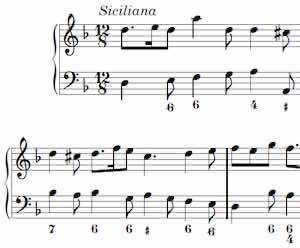Top > Musical Styles and Theory > Basso Continuo
This site introduces unknown composer Emanuel Bach (C. P. E. Bach). This English version was translated from Japanese one by ChatGPT.
Basso Continuo
Basso Continuo, primarily used during the Baroque period (circa 1600–1750), was an accompaniment technique that formed the foundation of musical compositions. It consists of a “bass line” performed by low-pitched instruments and a “harmonic part” where chords are improvised to complement the music.
Instruments commonly used for the bass line included the cello, violone, and bassoon. The harmonic part was played by chordal instruments such as the harpsichord, organ, lute, and theorbo. Performers improvised appropriate chords based on symbols known as “figured bass” written in the score.

Basso continuo was widely used across various musical forms, from solo pieces to large ensemble works and operas. For example, in Bachʼs cantatas and Vivaldiʼs concertos, the basso continuo played a crucial role in supporting the harmonic structure. Additionally, as accompaniment for vocal and instrumental solos, it allowed performers expressive freedom, adding depth and flexibility to the music.
Although basso continuo gradually declined during the Classical period, it has been revived in modern times as an essential technique for performing and studying Baroque music. Its improvisational nature and structural clarity are now recognized as effective means of conveying musical expression to both performers and audiences.